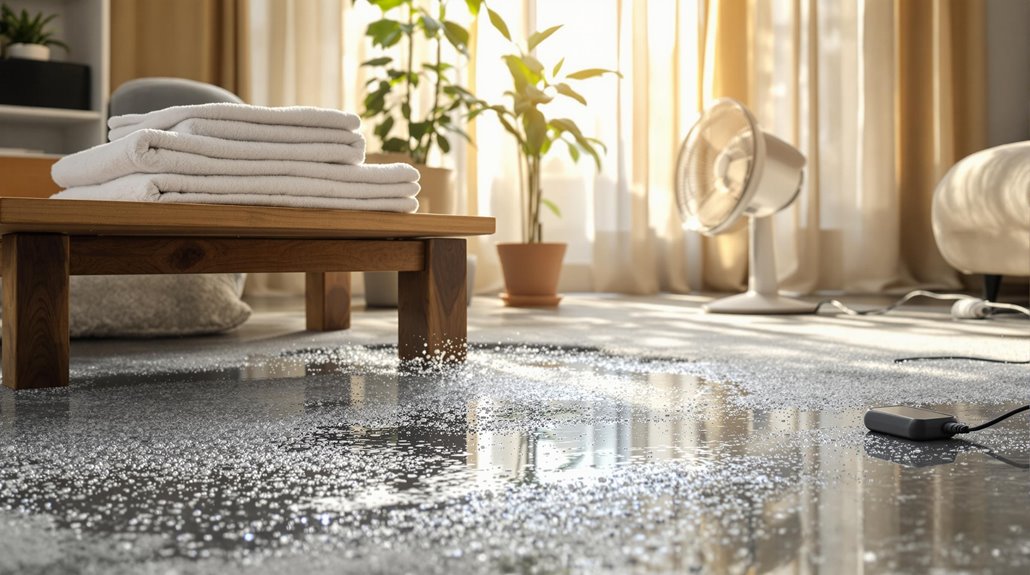To minimize water damage while waiting for professional help, act swiftly. First, identify and shut off the main water supply to stop further leakage. Remove standing water using a wet/dry vacuum or buckets and mops. Raise furniture and valuables to prevent soaking. Use dehumidifiers and open windows to manage indoor humidity levels, ideally between 30% and 50%. Document the damage with photos for insurance claims, and communicate key details to restoration professionals. Taking these steps helps reduce damage considerably, and if you investigate further, you'll find additional tips to improve your response.
Key Takeaways
- Shut off the main water supply to prevent further leaks and minimize water flow into affected areas.
- Remove standing water using a wet/dry vacuum or buckets to reduce moisture levels quickly.
- Elevate furniture and valuables using blocks or pallets to protect them from water exposure.
- Use dehumidifiers and open windows to enhance ventilation and decrease indoor humidity.
- Document all damage thoroughly with photos and notes for insurance purposes and restoration professionals.
Assess the Situation Quickly
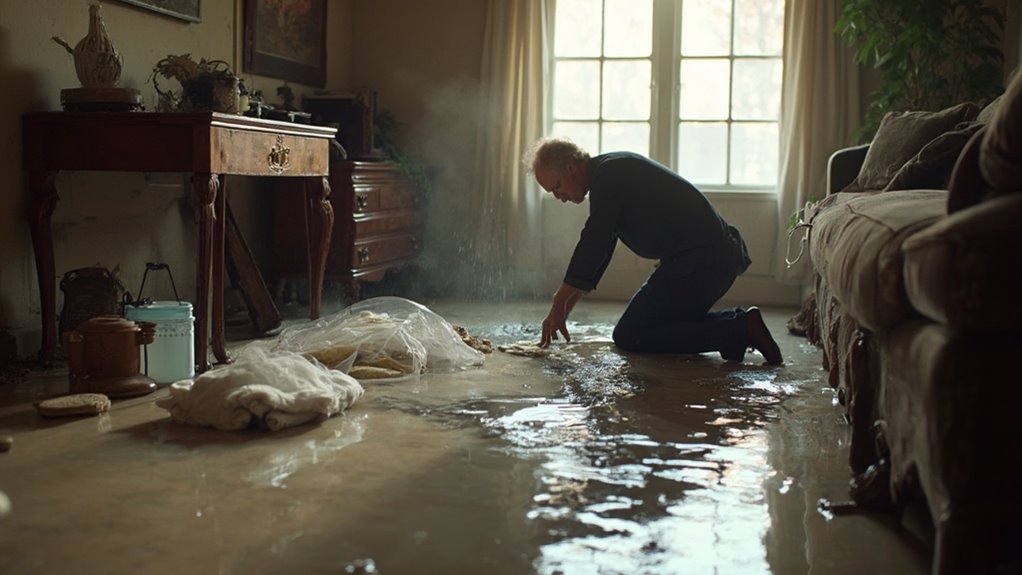
When you encounter water damage, it's crucial to assess the situation quickly to minimize further harm. Start by identifying the water source. Determine whether it's from plumbing leaks, appliance malfunctions, or natural disasters. Focus on areas with significant appliances, such as HVAC systems, basements, and crawl spaces. Don't overlook spaces directly above water-damaged ceilings, like attics, or lower floors beneath wet bathroom floors.
Next, conduct a thorough visual inspection. Look for signs of damage, including cracking drywall, discoloration, or mold growth. Inspect all affected areas, including walls, ceilings, and floors, for physical damage like swelling or buckling. Document any structural issues and signs of water absorption in furnishings. It's important to note that damp environments can promote mold and mildew growth within just 24 hours.
Assess moisture levels using moisture meters and infrared cameras to identify hidden moisture. High humidity levels may indicate excess moisture in concealed areas. Utilize borescopes to inspect hard-to-reach spots. Comprehensive evaluations can help identify the full extent of damage that may not be immediately visible.
Finally, document the damage meticulously. Take photos and videos, noting any mold growth or structural concerns. This detailed damage assessment is vital for effective emergency response and guides your restoration efforts while waiting for professional help.
Shut Off Water Supply
To effectively minimize water damage, shutting off the water supply is a critical step that you shouldn't overlook. First, locate the main water supply valve, usually found where the main supply line enters your home. Common locations include the basement, crawl space, or near the water meter. In colder climates, it's often near the front of the house, while in warmer areas, it's typically outside on an exterior wall.
Next, identify the type of valve you're dealing with—either a gate valve or a ball valve. The gate valve resembles a wheel and requires several turns to operate, while a ball valve features a lever handle that you turn 90 degrees. To shut off the valve, turn the gate valve clockwise until it stops or position the ball valve's lever perpendicular to the pipe.
After shutting off the water valve, verify that the water flow has ceased by checking a faucet. If water still flows, reassess the valve's position. To drain the plumbing system, open all faucets from top to bottom, leaving them open until the plumbing work is completed. This guarantees effective water management, a key aspect of plumbing basics. Additionally, prompt action in shutting off the water supply can significantly reduce property damage by up to 17% reduction in water-related incidents.
Remove Standing Water
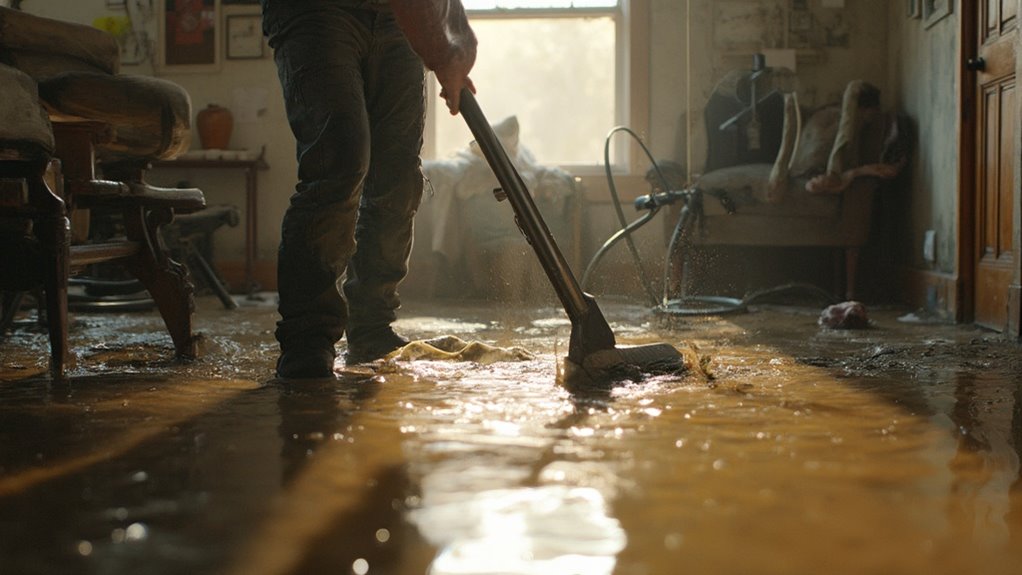
How quickly you remove standing water can greatly impact the extent of water damage in your home. Begin by using appropriate tools such as a wet/dry vacuum for efficient water extraction techniques. For initial removal, utilize buckets or plastic tubs, and follow up with mops to absorb water in hard-to-reach areas. Employ a wide, flat attachment on the vacuum hose for maximum suction. If water accumulates in basements or crawl spaces, a sump pump is crucial for drainage.
Safety is paramount; wear rubber-soled boots and gloves to minimize electrical shock risks. Avoid touching any electrical devices until the area is completely dry, and verify the space is well-ventilated to prevent further moisture buildup.
Extract standing water as quickly as possible to mitigate mold growth and additional damage. Direct extracted water away from your home's foundation. For water-logged carpets, pass over them multiple times with the vacuum to guarantee thorough drying. Utilize dehumidifiers and fans to expedite drying, while monitoring the process to confirm all areas are completely dried out. Address any waterlogged materials promptly to avoid long-term issues.
Protect Valuables and Furnishings
To minimize water damage, you need to lift your furniture and valuable items to protect them from potential floodwaters. Use concrete blocks to raise furniture above the anticipated water level and cover them with protective sheeting to shield against leaks. Moreover, store smaller valuables in waterproof containers to guarantee their safety during a flood event.
Elevate Furniture and Valuables
Raising furniture and valuables is crucial for minimizing water damage during a flood. Start by employing effective furniture elevation techniques; use blocks, pallets, or non-porous objects like coasters or Styrofoam to lift furniture legs off the ground, reducing direct contact with floodwater. Make certain that the elevated furniture is placed in a well-ventilated area to promote drying and avoid stacking heavy items on lower boxes, which can create instability.
For valuable storage solutions, prioritize relocating items to higher ground, such as upper floors or attics. If that's not feasible, utilize waterproof containers for protection. For electronics, seal them in resealable plastic bags and airtight containers before relocating. Document your actions with photos for insurance purposes.
Be resourceful by using household items to raise valuables; for instance, place wood blocks or aluminum foil under heavy furniture legs. Moreover, consider using desiccants like silica gel packets within containers to absorb moisture. Keep stacks of boxes stable by limiting their height to three or four boxes. Regularly inspect the elevated area to catch any signs of moisture before they develop into larger issues.
Use Protective Covers
What measures can you take to protect your valuables and furnishings from water damage? Using protective covers is crucial for effective flood prevention. Start by employing gutter covers to prevent leaves and debris from clogging your gutters. These protective barriers allow rainwater to flow freely, minimizing the risk of water damage during heavy storms.
Next, safeguard your outdoor outlets with weatherproof and in-use outlet covers. This prevents moisture intrusion, lowering the risk of electrical shocks and fire hazards. For sensitive electronics, relocate items from basements and disconnect them from power supplies. Store these items in resealable plastic bags or airtight containers to keep them dry, and use packing materials like bubble wrap for added protection.
Custom flood covers are also critical for immovable equipment like generators. Choose military-grade, waterproof materials that can withstand high wind speeds, ensuring a secure fit tailored to the equipment's shape. Anchoring these covers properly provides complete coverage, protecting your assets from potential water damage. By implementing these strategies, you create an all-encompassing shield against the threats posed by flooding.
Manage Indoor Humidity
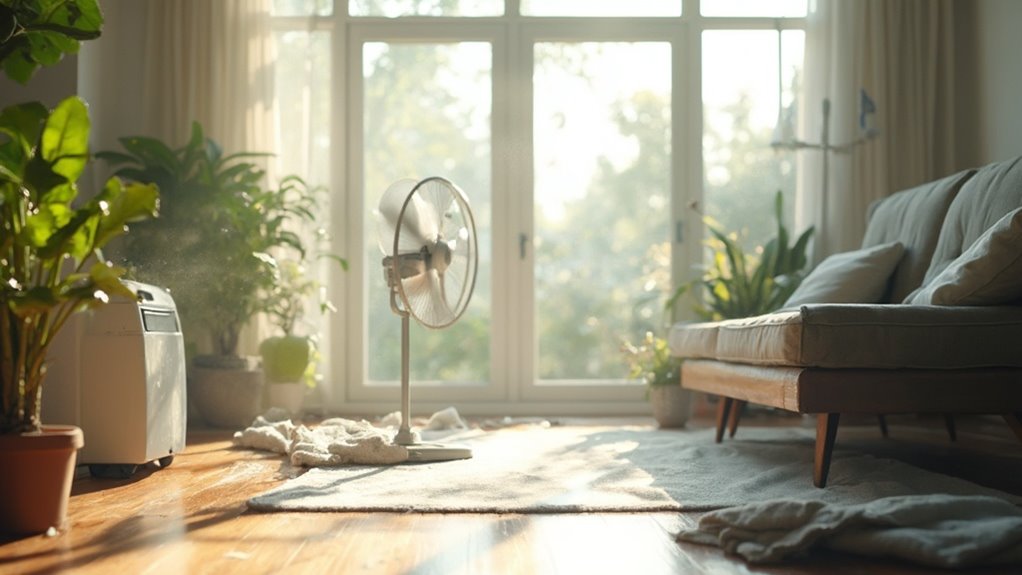
Maintaining ideal indoor humidity is crucial for preventing water damage and mold growth. To achieve effective humidity control, aim to keep humidity levels between 30% and 50%. Utilize dehumidifiers to actively reduce moisture in the air, especially in hot, humid climates. Installing air conditioning not only cools but also circulates air, helping to carry moisture away.
Enhance ventilation by opening windows to allow fresh air in and moisture to escape. Use exhaust fans in kitchens, bathrooms, and laundry areas to actively remove excess humidity. Avoid drying clothes indoors, as this generates unnecessary moisture, and vent clothes dryers to the outside.
Furthermore, maintain proper insulation in walls and attics to minimize condensation on cold surfaces. Keeping your home consistently heated reduces the risk of moisture accumulation. Be mindful of moisture-generating activities; limit long showers and avoid boiling excessive water when possible. Fix any leaks promptly and verify that gutters and downspouts are clean and functioning correctly.
Document the Damage
Documenting water damage promptly is essential for effective recovery and insurance claims. Start by prioritizing safety; verify the electricity is turned off and wear protective gear like gloves and waterproof boots. Avoid hazardous areas until professionals arrive and use flashlights instead of candles to minimize fire risks.
Next, capture clear photos and videos as visual evidence of the damage. Take wide-angle shots of the entire affected area, and zoom in on specific items and structures. Document the water damage's source, whether it's a broken pipe or roof leak, and capture multiple angles to provide an all-encompassing view. Confirm the images are well-lit to highlight the extent of the damage.
Create a detailed inventory of the damaged items, including descriptions, conditions before damage, and estimated values. Record replacement costs and any serial or model numbers. Maintain meticulous records and receipts for temporary repairs and related expenses. Document all communications with your insurance company as well. Finally, write a detailed incident report that includes the date, time, and cause of the damage. This thorough damage documentation will promote a smoother recovery process.
Communicate With Professionals
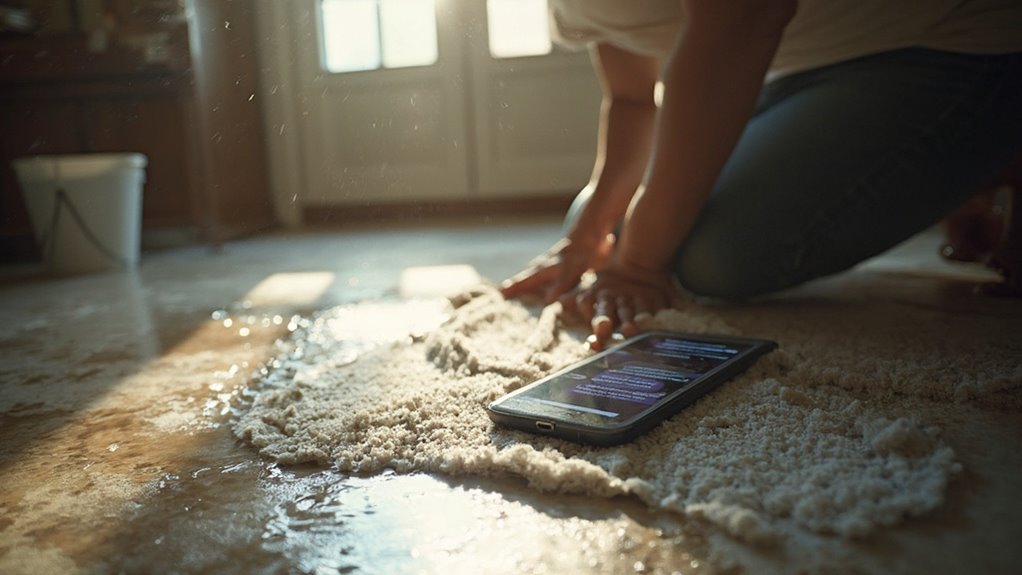
Effective communication with restoration professionals is crucial for managing the complexities of water damage recovery. Start by sharing pertinent details about the cause of the damage and any immediate safety concerns. Providing detailed information about the extent of the damage allows professionals to devise an appropriate restoration strategy. Regularly seek project updates and ask questions to stay informed about the progress of the work being done.
Establish clear expectations by outlining the necessary steps and preliminary timeline for the restoration process. This guarantees everyone involved is aligned, preventing misunderstandings and confusion as the project advances. Clarify what aspects are covered by insurance and how the claims process will unfold.
Guarantee accessible communication channels by designating a dedicated point of contact for the project. This person can promote effective feedback and streamline communication among team members. Keep multiple channels open—phone, email, or in-person meetings—so the restoration team remains reachable at all times.
Finally, be prepared to manage unforeseen challenges. Promptly discuss any changes to the project scope or timeline, and collaborate with the professionals to determine the best course of action.
Implement Preventive Measures
To effectively minimize water damage, you need to implement regular plumbing inspections to catch leaks early. Establish a gutter maintenance routine to guarantee proper drainage and prevent overflow. Moreover, controlling indoor humidity will help protect your home from moisture-related issues.
Regular Plumbing Inspections
While you might think routine plumbing checks are unnecessary, they play an important role in preventing major issues before they escalate. Regular plumbing inspections are vital for effective leak detection and can save you significant time and money. By identifying minor leaks early, you can avoid extensive water damage and costly repairs that could compromise your home's safety.
- Prevent mold growth and health hazards
- Extend the lifespan of your plumbing system
- Save money on emergency repairs
- Maintain a safe and healthy living environment
- Guarantee peace of mind for your family
During inspections, focus on areas like under sinks, around toilets, and near water heaters to catch any signs of moisture. Testing water pressure and examining visible plumbing components can provide insights into your system's condition. Consider scheduling annual or biannual professional inspections to stay ahead of potential issues. Proactive maintenance not only identifies problems but likewise helps you replace pipes and fittings before they fail. By committing to regular inspections, you confirm that your plumbing remains in ideal condition, safeguarding your home from unforeseen water damage.
Gutter Maintenance Routine
A consistent gutter maintenance routine is vital for protecting your home from water damage. To effectively minimize risks, schedule gutter inspections at least twice a year—once in spring and once in fall. If your home is surrounded by trees, increase that frequency to three or four times annually, focusing particularly on fall when leaves accumulate. After significant weather events, clear out gutters to prevent clogs that can lead to overflow.
During your seasonal cleaning, use a hose, brush, or gutter scoop to remove debris efficiently. For homes with easily accessible gutters, consider DIY cleaning; otherwise, enlist professional help for taller structures. Installing gutter guards can likewise be beneficial, as they reduce the amount of debris entering the system, lessening the need for frequent cleanings.
Don't overlook downspouts; verify they're clear and functioning properly. Inspect them for damage and use extenders to direct water away from your foundation. By adhering to this gutter maintenance routine, you'll improve your home's defenses against water damage, confirming that your drainage system functions effectively throughout the year.
Indoor Humidity Control
Indoor humidity control is essential for maintaining a comfortable and healthy living environment. Effective moisture management not only prevents water damage but likewise promotes overall well-being. To master indoor humidity control, consider implementing these strategies:
- Use exhaust fans in kitchens and bathrooms to vent moisture outside.
- Install ducted kitchen exhaust hoods for superior air quality.
- Keep interior doors open to improve air circulation.
- Utilize air conditioning to regulate humidity levels effectively.
- Regularly inspect heating and cooling systems to guarantee optimal performance.
In addition, employing moisture-reducing practices can greatly reduce humidity. Cover pots while cooking, avoid drying clothes indoors, and store firewood outside to minimize moisture release. Insulation improvements, such as installing double-pane windows and using caulking, greatly boost energy efficiency while preventing humid air entry.
Conclusion
In the face of water damage, acting swiftly is your best defense. By evaluating the situation, shutting off the water supply, and removing standing water, you can greatly reduce the impact. Protecting your valuables and managing humidity will further safeguard your home. Think of it as a life raft in a storm; every action you take contributes to keeping your property afloat. Remember, documenting the damage aids communication with professionals, ensuring a smoother recovery process.



